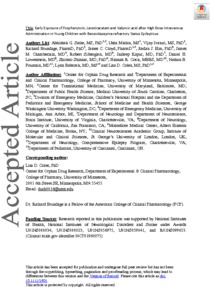Sathe, AG;
Mishra, U;
Ivaturi, V;
Brundage, R;
Cloyd, JC;
Elm, JJ;
Chamberlain, JM;
Silbergleit, R;
Kapur, J;
Lowenstein, DH;
et al.
Sathe, AG; Mishra, U; Ivaturi, V; Brundage, R; Cloyd, JC; Elm, JJ; Chamberlain, JM; Silbergleit, R; Kapur, J; Lowenstein, DH; Shinnar, S; Cock, HR; Fountain, NB; Babcock, L; Coles, LD
(2021)
Early Exposure of Fosphenytoin, Levetiracetam and Valproic acid after High Dose Intravenous Administration in Young Children with Benzodiazepine-refractory Status Epilepticus.
J Clin Pharmacol, 61 (6).
pp. 763-768.
ISSN 1552-4604
https://doi.org/10.1002/jcph.1801
SGUL Authors: Cock, Hannah Rutherford
![[img]](https://openaccess.sgul.ac.uk/112737/1.hassmallThumbnailVersion/Sathe%20ESETT%20JCP%202020.pdf)  Preview |
|
PDF
Accepted Version
Available under License ["licenses_description_publisher" not defined].
Download (678kB)
| Preview
|
Abstract
Fosphenytoin (FOS) and its active form, phenytoin (PHT), levetiracetam (LEV), and valproic acid (VPA) are commonly used second-line treatments of status epilepticus. However, limited information is available regarding LEV and VPA concentrations following high intravenous doses particularly in young children. The Established Status Epilepticus Treatment Trial (ESETT), a blinded, comparative effectiveness study of FOS, LEV, and VPA for benzodiazepine-refractory status epilepticus provided an opportunity to investigate early drug concentrations. Patients ≥ 2 years who continued to seizure despite receiving adequate doses of benzodiazepines were randomized to FOS, LEV or VPA infused over 10 minutes. A sparse blood sampling approach was used, with up to two samples collected per patient within two hours following drug administration. The objective of this work was to report early drug exposure of PHT, LEV and VPA and plasma protein binding of PHT and VPA. Twenty-seven children with median (interquartile range) age of 4 (2.5, 6.5) years were enrolled. The total plasma concentrations ranged from 69-151.3 μg/mL for LEV, 11.3-26.7 μg/mL for PHT and 126-223 μg/mL for VPA. Free fraction ranged from 4-19% for PHT and 17-51% for VPA. This is the first report in young children of LEV concentrations with convulsive status epilepticus as well as VPA concentrations after a 40 mg/kg dose. Several challenges limited patient enrollment and blood sampling. Additional studies with a larger sample size are required to evaluate the exposure-response relationships in this emergent condition. This article is protected by copyright. All rights reserved.
| Item Type: |
Article
|
| Additional Information: |
This is the peer reviewed version of the following article: Sathe, A.G., Mishra, U., Ivaturi, V., Brundage, R.C., Cloyd, J.C., Elm, J.J., Chamberlain, J.M., Silbergleit, R., Kapur, J., Lowenstein, D.H., Shinnar, S., Cock, H.R., Fountain, N.B., Babcock, L. and Coles, L.D. (2021), Early Exposure of Fosphenytoin, Levetiracetam, and Valproic Acid After High‐Dose Intravenous Administration in Young Children With Benzodiazepine‐Refractory Status Epilepticus. The Journal of Clinical Pharmacology, 61: 763-768, which has been published in final form at https://doi.org/10.1002/jcph.1801. This article may be used for non-commercial purposes in accordance with Wiley Terms and Conditions for Use of Self-Archived Versions. |
| Keywords: |
Central Nervous System (CNS), Clinical Pharmacology (CPH), Clinical Trials (CTR), Emergency Medicine (EME), Neurology (NEU), Pediatrics (PED), Pharmacokinetics and drug metabolism, exposure-response, protein binding, sparse sampling, 1115 Pharmacology and Pharmaceutical Sciences, Pharmacology & Pharmacy |
| SGUL Research Institute / Research Centre: |
Academic Structure > Institute of Medical & Biomedical Education (IMBE)
Academic Structure > Institute of Medical & Biomedical Education (IMBE) > Centre for Clinical Education (INMECE ) |
| Journal or Publication Title: |
J Clin Pharmacol |
| ISSN: |
1552-4604 |
| Language: |
eng |
| Dates: |
| Date | Event |
|---|
| 1 May 2021 | Published | | 12 January 2021 | Published Online | | 14 December 2020 | Accepted |
|
| Publisher License: |
Publisher's own licence |
| Projects: |
|
| PubMed ID: |
33336359 |
 |
Go to PubMed abstract |
| URI: |
https://openaccess.sgul.ac.uk/id/eprint/112737 |
| Publisher's version: |
https://doi.org/10.1002/jcph.1801 |
Statistics
Item downloaded times since 04 Jan 2021.
Actions (login required)
 |
Edit Item |



